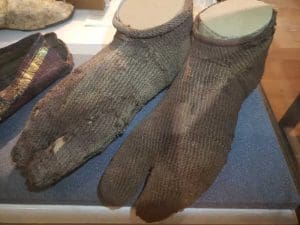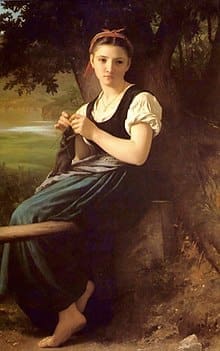Knitting is the process of using two or more needles to loop yarn into a series of interconnected loops in order to create a finished garment or some other type of fabric. The word is derived from knot, thought to originate from the Dutch verb knutten, which is similar to the Old English cnyttan, “to knot”. Its origins lie in the basic human need for clothing for protection against the elements. More recently, hand knitting has become less a necessary skill and more a hobby.
Knitting, like many other craft hobbies, has a rich past, but an accurate and factual account is quite challenging to find.
Early Origins:
Knitting is a technique of producing fabric from a strand of yarn or wool. Unlike weaving, knitting does not require a loom or other large equipment, making it a valuable technique for nomadic and non-agrarian peoples.

Imagine credits to Jodie Morgan.
The oldest knitted artifacts are socks from Egypt, dating from the 11th century CE. They are a very fine gauge, done with complex colorwork and some have a short row heel, which necessitates the purl stitch. These complexities suggest that knitting is even older than the archaeological record can prove.
Earlier pieces having a knitted or crocheted appearance have been shown to be made with other techniques, such as Nålebinding, a technique of making fabric by creating multiple loops with a single needle and thread, much like sewing. Some artifacts have a structure so similar to knitting, for example, 3rd-5th century CE Romano-Egyptian toe-socks, that it is thought the “Coptic stitch” of nalbinding is the forerunner to knitting.
Most histories of knitting place its origin somewhere in the Middle East, and from there it spread to Europe by Mediterranean trade routes and later to the Americas with European colonization.
Early European Knitting:
The earliest known knitted items in Europe were made by Muslim knitters employed by Spanish Christian royal families. Their high level of knitting skill can be seen in several items found in the tombs in the Abbey of Santa María la Real de Las Huelgas, a royal monastery, near Burgos, Spain. Among them are the knitted cushion covers and gloves found in the tomb of Prince Fernando de la Cerda, who died in 1275.
Although the purl stitch is in items from Ancient Egypt, the expertise was probably lost in Europe.
The word knit only became listed in the Oxford Unabridged English Dictionary in the 15th century.
The first examples with the purl stitch in places other than Egypt appeared in the mid 16th century. During the reign of Queen Elizabeth I, the demand for stockings increased. She was a great fan of knitted silk stockings, the fabric was so soft. Knitting schools were set up as a way of providing income for the poor.
Industrial Revolution:
The mechanical knitting machine was invented in 1589 by William Lee, an English clergyman. After receiving a pair of black stockings from William, Queen Elizabeth I ultimately declined to grant him a patent for his invention. She complained that his machine made wool stockings that were far too coarse for royal ankles.
The city of Nottingham, particularly the district known as Lace Market, was a major producer of machine-knitted lace. The city’s profits grew with the invention of portable circular knitting machines.
By the middle of the nineteenth century, the knitting industry had still not made the transition to factories. With the improvement of steam-powered knitting machines in the mid-nineteenth century, machine knitting increasingly shifted to factories to accommodate the larger machines.
By the mid-nineteenth century, hand knitting was declining as part of the knitting industry, but was increasing as a hobby. Printed knitting patterns and yarn were produced for leisure as well as for industrial use.
1920s : Including Knits Into Fashion
An increase in the popularity of knitwear was seen in much of the fashion world during this era. Knitwear, especially sweaters/pullovers became essential part of the new fashions of the age for men, women and children, rather than mostly practical garments of associated with particular occupations (e.g., fishermen).
Knitwear was often associated with sport and leisure. Garments often became associated with particular sports; for example, white sweaters/pullers, often with coloured stripes (club colours) in the collar, became common for tennis and cricket.
High fashion also embraced knitwear, with Coco Chanel making prominent use of it and Vogue magazine featuring patterns.
Before the 1920s, the majority of commercial knitting in the Western world had centered around production of underwear, socks and hosiery. This vastly expanded as the public taste for knitted fashion did also. Both hand and machine knitting were commercially active on a large scale prior to the Great Depression.
1930s: Depression
The prominence of knitwear in fashion of the 1920s continued. But some changes were seen such as combination of traditional methods and new technologies, they became more common. These changes included addition of zip fasteners and new synthetic yarns in knitwear.
The hardship experienced by many during the Great Depression meant some turned to knitting through necessity. It was much cheaper to knit your own garments than to buy hand (or even machine) knitted products.
Knitting was an essential skill during that time as socks, underwear, and other items needed constant repair. Patterns were increasingly featured in women’s magazines, reflecting the need for hand-knitting. Some people took a part-time job, hand crafting for profit.
1950s and 60s: Haute Couture
After the war years, knitting had a huge boost as greater colours and styles of yarn were introduced. Many thousands of patterns fed a market hungry for fashionable designs in bright colours. The twinset was an extremely popular combination for the home knitter. It consisted of a short-sleeved top with a long-sleeved cardigan in the same colour, to be worn together.
Girls were taught to knit in school, as it was thought to be a useful skill, not just a hobby. Magazines such as Pins and Needles in the UK carried patterns of varying difficulty including not just clothes, but also blankets, toys, bags, lace curtains and other items that could be sold for profit.
Decline In The 1980s:
The popularity of knitting showed a sharp decline during this period in the Western world. Sales of patterns and yarns slumped, as the craft was increasingly seen as old-fashioned and children were rarely taught to knit in school.
The increased availability and low cost of machine-knitted items meant that consumers could have a sweater at the same cost of purchasing the wool and pattern themselves, or often for far less.
Alternatives to traditional woollen knitwear gained in popularity, such as tracksuits and sweatshirts, which began to be worn as everyday wear rather than only in a sporting context.
Advances in technology saw digital versions of knitting machines. As a result, more attention was on the design aspect, rather than uses for fashion or functional means.
21st Century: Knitwear Gains Popularity
The 21st century has seen a resurgence of knitting. This happened mostly because of the growth of internet and people’s interest in DIY crafts.
Natural fibers, from animals such as alpaca, angora, merino and mohair, and plant fibers such as cotton, became more accessible and cheaper to obtain and process. Other fibers, such as bamboo, qiviut, silk, and yak were gaining popularity as well.
The yarn industry began making new types of “Novelty Yarns,” using a blend of natural and man-made fibers. These yarns were unique because the final results turned out to be stunning, years of trial and error were not necessary.
Traditional designs blended with non-traditional is happening more than ever today. Many makers hold on to the conventional patterns, which have gained a large following.
This wonderful skill is being adapted, added to, reinvented and blended all the time. What we know as knitting today will be something different in the future.
Nevertheless, it has survived the test of time and will continue to do so.
Reference:
Morgan, J. (2020b, April 12). The Amazing History Of Knitting. A Look Through The Ages Into Knitting History And Who Invented It. Retrieved from https://knitlikegranny.com/knitting-history/
Wikipedia contributors. (2020a, April 6). History of knitting. Retrieved from https://en.m.wikipedia.org/wiki/History_of_knitting

